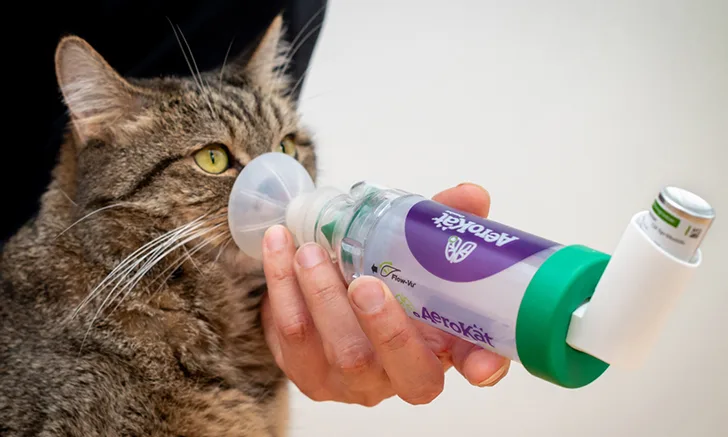Home Management of Respiratory Attacks in Feline Asthma Patients

Sponsored by Trudell Animal Health
Feline asthma is a lower airway disease affecting up to 5% of cats, most commonly in young to middle-aged cats.1 Asthma is an inflammatory disease believed to be allergic in nature, with the most common clinical signs being coughing and wheezing.1,2 Chronic airway inflammation can cause irreversible remodeling of the lower airways, leading to progressive disease. In addition to progressive disease, a subset of asthmatic cats can develop severe bronchospasm, resulting in acute breathing difficulties that have the potential to be life-threatening.3
When a cat is struggling to breathe in the clinic, the veterinary team has many therapeutic options to bring the patient relief (eg, oxygen cages, sedation, injectable medications), but when a cat is struggling to breathe at home, frightened owners are much more limited in their options. Although seeking emergency veterinary care is the best course of action, the risk for decompensation remains during transit and may even be worsened by the stress of transportation.
Equipping owners of at-risk cats with rescue inhalers can empower them to start appropriate lifesaving measures as soon as possible before heading to a veterinary clinic.
What Is the Role of Inhalers in Feline Asthma?
Pressurized metered-dose inhalers, simply referred to as inhalers, use compressed propellants to aerosolize drugs and deliver them to the lungs.3-5 Inhalers can be used to administer glucocorticoids (eg, fluticasone) or bronchodilators (eg, beta-2 agonists such as albuterol). Glucocorticoids are the mainstay of treatment in the asthmatic patient, as they decrease inflammation, reduce the risk for bronchospasm, and can be used long-term rather than as a rescue therapy.3 Bronchodilators (eg, beta-2 agonists such as albuterol) work to relieve bronchospasm and can be utilized during at-home respiratory attacks.3-5
Albuterol (salbutamol) is a short-acting beta-2 agonist and the medication of choice for inhaled rescue treatment of bronchoconstriction,5 which can occur in response to specific allergens or nonspecific irritants, reducing airway diameters and airflow.3 Albuterol relaxes the spasmed smooth muscles in the lungs within minutes, opening the airways and quickly improving airflow.3,5 Albuterol rescue therapy alone may be sufficient to counteract a trigger at home; however, severe bronchospasm (ie, status asthmaticus) requires prompt medical attention in addition to repeated albuterol administration.3
Although albuterol is excellent as a rescue medication for acute respiratory attacks, it is inappropriate for chronic use as a monotherapy for patients with reactive airway disease such as feline asthma.3,5 Along with being short-lived (effects last 3-6 hours), albuterol does not address underlying inflammation, putting the cat at risk for triggers that can cause severe flare-ups.3,5 Albuterol should be reserved for temporary symptomatic support, with anti-inflammatory treatment (eg, inhaled, oral, or injectable glucocorticoids) being the mainstay of inflammatory airway disease treatment.3
For an algorithm on how to manage feline asthma and canine bronchitis, visit cliniciansbrief.com/article/managing-feline-asthma-canine-bronchitis
How to Use Rescue Inhalers
Rescue inhalers should be used during emergent respiratory attacks (eg, wheezing, expiratory distress).3 Inhaled albuterol should be dosed as one 90-microgram actuation (ie, puff) up to 3 times every 5 to 15 minutes in cats.6 Because closed airways may block delivery of albuterol into the lower airways, repeated dosing (every 15 minutes) may be necessary to consecutively open up airways, allowing the drug to penetrate deeper into the airway and reach maximum effect.3 Any pet failing to regain airway control from use of a rescue inhaler should seek emergent veterinary care. If owners find they are reaching for the rescue inhaler >2 to 3 times a week, it is best to modify the overall management plan for better chronic control, as chronic use of albuterol can have paradoxical proinflammatory effects.3,5
Because pets are not able to coordinate breathing with an actuation, inhaled medications must be administered with the use of a valved-holding chamber (commonly called a “spacer”) and species-specific mask.3-5 Using a spacer holds the medication, allowing them to breathe a complete dose in during regular tidal breathing.3,4 Because pets may have lower tidal volumes than humans and not all spacers perform similarly, it is most prudent to use a veterinary spacer, which is designed to hold the medication longer within the chamber and fitted with valves for lower tidal volume of pets with respiratory disease.7-9 For successful delivery, animals must be trained to use the inhaler.3-5,8
Albuterol is very safe when used intermittently for symptomatic relief.5 Severe adverse effects are only expected with massive overdoses (eg, when a pet bites into an inhaler and receives as many as 200 actuations at once).5,6 Serious tachycardia, hypertension, and hypokalemia can occur with a massive overdose.5,10 For this reason, inhalers should always be stored out of reach of pets.
Conclusion
As a safe and potentially life-saving treatment, rescue inhalers are a crucial tool for asthmatic cats that may be at risk for severe bronchospam.1 When veterinarians prescribe albuterol inhalers, spacers, and masks to cats with feline asthma, their owners can feel empowered to start life-saving treatment at home.
